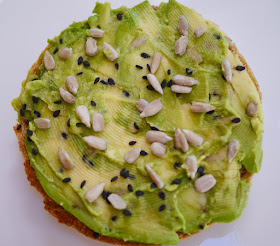 |
| Bagels ideas for breakfast, lunch or dinner. Follow Foods For Long Life on Facebook and Pinterest. |
Bagels Make a Quick and Easy Meal
Who doesn't love a good bagel? But we mostly just toast them, slather cream "cheese" or "butter" on them, and call it a meal. But there's so much more you can do to make these little platters of goodness more interesting. And they can be enjoyed for breakfast, lunch or dinner!
Starting Out
Start with a good bagel. I'm in love with the Sprouted Wheat bagels by Alvarado Street Bakery. They are not gluten free but they do not contain added gluten, like so many baked goods do. Their main ingredient is Sprouted Organic Whole Wheat Berries. As stated on their package:
"We sprout the whole grains by soaking them in filtered water for several days, until they begin to grow. We then transform these living sprouts into the unique dough that becomes the basis of all our recipes. Sprouting grains helps to increase the availability of some nutrients, are easy to digest, and contain essential vitamins, minerals, and fiber."
 |
| Each bagel provides: 250 calories 0.5 total fat, 0 g saturated fat, 0 mg cholesterol 51 g carbohydrates, 2 g sugar 10 g protein 3 g dietary fiber 410 mg sodium |
#1 - Super Seeded Bagel
If you like seeded bagels, you will love this one. When you buy a seeded bagel, the seeds are baked in the process of making it and then toasted when you take it home. All this cooking destroys the delicate essential fatty acids which is why I always prefer eating raw seeds and nuts. For this recipe, just slather Kite Hill vegan cream cheese on your bagel (toasted or not), and cover it with raw seeds, such as hemp, sunflower, and pumpkin.
 |
| Super Seeded Bagel |
#2 - The Elvis Bagel
This recipe pays homage to Elvis, who loved his peanut butter and banana sandwiches. We top this one with walnuts for a little extra omega-3 fatty acids. I don't think Elvis paid much attention to that :-) Spread organic peanut butter (creamy or crunchy) on the bagel and top with ripe banana slices and crushed walnuts.
 |
| Elvis Bagel |
#3 - Avocado Bagel
As I posted earlier this month, Avocado Toast - It's Everywhere! Why It's a Healthy Dish, avocados contain healthy fat, have anti-inflammatory properties, and are a great source of fiber and a host of vitamins and minerals. They also help us absorb cancer-fighting carotenoids. So just slice or smush avocado on your bagel and top with raw seeds, sprouts, fruits, veggies, herbs, or whatever suits you.
 |
| Avocado Bagel |
#4 - Garlic Toast Bagel
A garlic toasted bagel makes a tasty side to a big raw salad. Just make a paste by mixing a tablespoon of room temperature Miyoko's vegan butter, (or your favorite spread), with a clove or two of pressed or finely minced garlic and dried parsley flakes. Spread it on the bagel and toast until brown and bubbly.
 |
| Garlic Toast Bagel |
#5 - Jalapeno Hummus Bagel
This bagel is sure to spice up your life. Spread your favorite hummus on a toasted bagel and top with pickled jalapeños and raw pumpkin seeds, or "pepitas."
 |
| Jalapeno Hummus Bagel |
#6 - Sweet Mango and Almond Butter Bagel
Sweet Ataulfo mangos are in season now and they pair beautifully with almond butter. Mangos are packed with vitamin A and C and a good source of dietary fiber. The almond butter is a great source of vitamin E, which is hard to get. Spread creamy or crunchy almond butter on your bagel, top with finely diced mango and top with black sesame seeds.
 |
| Mango and Almond Butter Bagel |
#7 - Pizza Bagel
This makes an easy lunch or dinner, with a raw salad. Just toast the bagel first then cover with thick (not runny) tomato sauce, and shredded vegan "cheese". Broil until the cheese melts and then top with whatever you like. I used artichoke hearts, roasted red peppers, kalamata olives, peperocini, vegan "parmesan" topping, and chili flakes. Toss under the broiler again the heat the veggies and serve.
 |
| Pizza Bagel |
#8 - Strawberry Fields Forever Bagel
Strawberries are in season now and they make a great topping over Kite Hill's vegan cream cheese. Toast and slather cream cheese on the bagel. Top with strawberry slices and hemp seeds, for that extra omega-3 punch. I also sprinkled it with some blueberry finishing salt to introduce extra flavor.
 |
| Strawberry Fields Forever Bagel |
I could go on and on with this post but I think I'll leave it here. If you have some interesting concoctions, please comment and share!
























